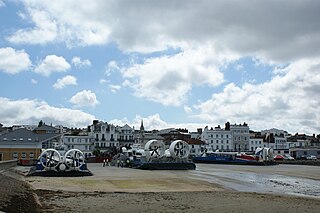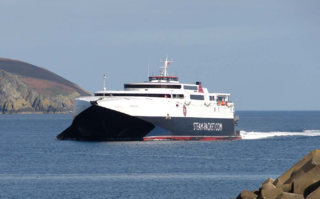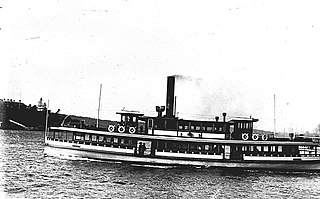
Gosport is a town and non-metropolitan borough on the south coast of Hampshire, South East England. At the 2011 Census, its population was 82,662. Gosport is situated on a peninsula on the western side of Portsmouth Harbour, opposite the city of Portsmouth, to which it is linked by the Gosport Ferry. Gosport lies south-east of Fareham, to which it is linked by a Bus Rapid Transit route and the A32. Until the last quarter of the 20th century, Gosport was a major naval town associated with the defence and supply infrastructure of Her Majesty's Naval Base (HMNB) Portsmouth. As such over the years extensive fortifications were created. In 2022, Peter Chegwyn became the Leader of Gosport Borough Council.

HMS Warrior is a 40-gun steam-powered armoured frigate built for the Royal Navy in 1859–1861. She was the name ship of the Warrior-class ironclads. Warrior and her sister ship HMS Black Prince were the first armour-plated, iron-hulled warships, and were built in response to France's launching in 1859 of the first ocean-going ironclad warship, the wooden-hulled Gloire. Warrior conducted a publicity tour of Great Britain in 1863 and spent her active career with the Channel Squadron. Obsolescent following the 1873 commissioning of the mastless and more capable HMS Devastation, she was placed in reserve in 1875, and was "paid off" – decommissioned – in 1883.

Portsmouth Harbour is a 1,264.2-hectare (3,124-acre) biological Site of Special Scientific Interest between Portsmouth and Gosport in Hampshire. It is a Ramsar site and a Special Protection Area.

Her Majesty's Naval Base, Portsmouth is one of three operating bases in the United Kingdom for the Royal Navy. Portsmouth Naval Base is part of the city of Portsmouth; it is located on the eastern shore of Portsmouth Harbour, north of the Solent and the Isle of Wight. Until the early 1970s, it was officially known as Portsmouth Royal Dockyard ; thereafter the term 'Naval Base' gained currency, acknowledging a greater focus on personnel and support elements alongside the traditional emphasis on building, repairing and maintaining ships. In 1984 Portsmouth's Royal Dockyard function was downgraded and it was formally renamed the 'Fleet Maintenance and Repair Organisation' (FMRO). The FMRO was privatized in 1998, and for a time, shipbuilding, in the form of block construction, returned. Around 2000, the designation HMS Nelson was extended to cover the entire base.

HMS Caroline is a decommissioned C-class light cruiser of the Royal Navy that saw combat service in the First World War and served as an administrative centre in the Second World War. Caroline was launched and commissioned in 1914. At the time of her decommissioning in 2011 she was the second-oldest ship in Royal Navy service, after HMS Victory. She served as a static headquarters and training ship for the Royal Naval Reserve, based in Alexandra Dock, Belfast, Northern Ireland, for the later stages of her career. She was converted into a museum ship. From October 2016 she underwent inspection and repairs to her hull at Harland and Wolff and opened to the public on 1 July 2017 at Alexandra Dock in the Titanic Quarter in Belfast.

The Gosport Ferry is a ferry service for pedestrians and cyclists operating between Gosport and Portsmouth in Hampshire, southern England. It is currently operated by Gosport Ferry Ltd, a subsidiary of the Portsmouth Harbour Ferry Company Ltd, itself a wholly owned subsidiary of FIH group plc.

Forton Lake is a tidal creek located in the town of Gosport, Hampshire. A small area of the lake is within the grounds of St Vincent College. The locality is the subject of a painting by Martin Snape, which hangs in Gosport Town Hall. The Lake itself is resident to local fish species, including shoal bass and pollack.

There are currently three different ferry companies that operate vessels carrying passengers and, on certain routes, vehicles across the Solent, the stretch of sea that separates the Isle of Wight from mainland England. These are Wightlink, Red Funnel and Hovertravel.

HSC Manannan is a 96-metre (315 ft) wave-piercing high-speed catamaran car ferry built by Incat, Australia in 1998. After commercial service in Australia and New Zealand, she was chartered to the US military as Joint Venture (HSV-X1). Now owned and operated by the Isle of Man Steam Packet Company, she mainly provides a seasonal service between Douglas Harbour and Port of Liverpool.

HMS LST 3519 was a Landing Ship, Tank of the Royal Navy, entering service during the last months of the Second World War. She was chartered for civilian service as the Empire Baltic from 1946, serving as an early RO-RO ferry until the navy suspended the charter and requisitioned the ship during the Suez Crisis in 1956. She briefly returned to normal service, but was retired soon after and was eventually sold for breaking up.

RML 497 is a former Royal Navy Fairmile B motor launch from World War II. She was named Western Lady III on her entry to civilian service, as a passenger motor vessel for Western Lady Ferry Service. From 2009 to 2015, she operated as The Fairmile for Greenway Ferry on their day cruise route from Torquay and Brixham to Dartmouth and Greenway. In May 2013, she was returned to her original wartime appearance. Torbay's "ferry wars" forced her removal from service, and in December 2015, RML 497 was acquired by the National Museum of the Royal Navy.

ST Cervia was built in 1946 as a seagoing tug for use as a fleet auxiliary by Alexandra Hall & Company Ltd of Aberdeen, Scotland. Today she is a floating Museum still undergoing restoration in Ramsgate, Kent.

The SS South Steyne is a former Manly ferry on Sydney Harbour. She was the world's largest steam-powered passenger ferry and operated on the service from 1938 to 1974. Restored in the 1980s, she served as a restaurant ship in Newcastle in the 1990s, and in 2000 was moved back to Sydney and open to the public at Darling Harbour. Since April 2016 she has been stored at Berrys Bay. She was added to the New South Wales State Heritage Register on 2 April 1999.

Burra Bra was a Manly ferry on Sydney Harbour that operated by the Port Jackson & Manly Steamship Company from 1908 until 1940, before being requisitioned by the Royal Australian Navy for use as an anti-submarine training vessel and target tow during World War II.

The MV North Head was a ferry operated by the Port Jackson & Manly Steamship Company and its successors on the Manly service from 1913 until 1985.

Lady Denman is a former Sydney Harbour ferry built in 1912 for the Balmain New Ferry Company. She was later run by Sydney Ferries Limited and its government successors. She is now preserved at the Jervis Bay Maritime Museum near her original build site in Huskisson, New South Wales, Australia.

Forton Barracks was a military installation near Gosport in Hampshire, which served first as an Army barracks and then as a divisional headquarters for the Royal Marines. It subsequently served as a Royal Navy training establishment. Today, the site is occupied by St Vincent College.

HMS Redpole was a modified Black Swan-class sloop of the Royal Navy. She was laid down by Yarrow Shipbuilders Limited, Scotstoun on 18 May 1942, launched on 25 February 1943 and commissioned on 24 June 1943, with the pennant number U69.

Kanangra is a retired ferry on Sydney Harbour. She was launched in 1912 during the early-twentieth century pre-Sydney Harbour Bridge boom years of Sydney Ferries Limited.

Steam Pinnace 199 is a steam pinnace of the Royal Navy, built in 1909 by J. Reid of Portsmouth. She is now owned by the National Museum of the Royal Navy, and is based at Portsmouth Historic Dockyard.




















